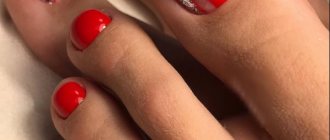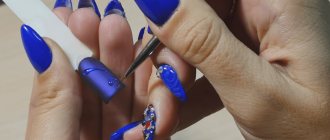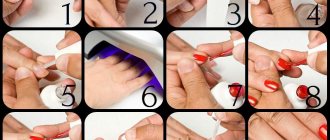The desire to look perfect in every detail is an integral quality of any girl or woman. Therefore, the modern beauty industry is constantly developing and moving forward by leaps and bounds in order to please every young lady and facilitate the titanic work of creating a unique and perfect image. And, of course, a beautiful original manicure is no exception.
The quality and durability of modern beauty products require special attention. To remove makeup, you will need special products; to remove your outdated decorative manicure, you will have to go to the salon. But before going, it wouldn’t hurt to find out how to remove shellac in a salon. There are several ways, which are detailed in the article.
What is shellac?
You might be interested in: Tips on how to get perfect nails
It all started with all kinds of varnishes that inveterate fashionistas used to cover their nails over the decades of the last century. Then they were replaced by gel polish, which was more practical in terms of durability, which for a number of reasons lost its position in favor of shellac. In 2010, the Creativ nail department released Shellac gel polish, which later (not unreasonably, by the way) turned out to be the most popular brand and became the starting point for a new type of designer manicure.
You may be interested in:How to choose a lamp for drying nails: types, technical characteristics and expert advice
How to remove gel polish from nails with remover?
Remover – in other words, a product designed to remove gel coatings. Experts recommend using a remover from the same company as the gel polish.
- So, we will need a file with which we can polish the nail - with it we will remove the gloss, as well as all the rhinestones, beads and other decorations.
- Then we take a sponge and soak it with remover, after which we put it on the nail according to the usual pattern and wrap it in foil. We hold the marigolds for 10 minutes, but you can do more - 15.
- Now we remove the gel polish along with a sponge or cotton wool and remove all unnecessary residues with a stick.

Using remover does not require any special skills, buy it and make your nails happy.
When should you think about updating your manicure?
The guaranteed period of wearing shellac manicure is from 10 to 14 days. With proper care, this period can be significantly extended. But in any case, the day will come when you need to remove your nail polish in a beauty salon. Because even if the coating itself is not damaged and remains intact and smooth, the nails tend to grow back. And after a while, a strip of nail appears that is not covered with shellac, which negatively affects the aesthetic side of the manicure.
You may be interested in: Is it worth getting nail extensions: pros and cons, possible consequences, reviews
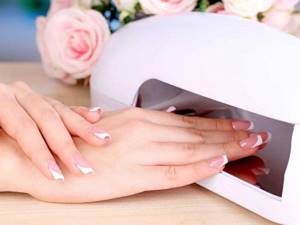
How to remove gel polish from nails with a file?
We want to warn you right away and warn you. Fileing off the gel is far from the best idea. This method is the least gentle because when cutting off the gel with a file or a special cutter, you can seriously damage the nail.
- In beauty salons, gel polish is most often removed using a special device, but for people who don’t know how, it’s better to give preference to a good old nail file.
- First we need to remove the free edge of the nail. This can be done using a file or tweezers. You need to act carefully and without haste so as not to damage the nail.
- Let's start cutting off the gel. We also do this carefully: from the cuticle to the edge of the nail.

Removal with a nail file
- We remove accumulated dust with a brush. To make it easier for us to see the remaining gel, we can periodically wipe the nail with a sponge moistened with alcohol.
- After these manipulations you need to polish the nail. We make it a buff.
- When the entire procedure is completed, lubricate the nail with cream or oil.
- Recommendation from experts: after such manipulations, give your nails a rest. Do not paint your nails or apply gel polish for the next week. Make all kinds of baths, pamper them with vitamins and oils.
How to remove shellac coating?
The main advantage of covering nails with shellac is the resistance of this manicure to any impact. Therefore, removing outdated shellac from a nail is quite a labor-intensive task.
Some desperate fashionistas perform this procedure at home using regular nail polish remover. In this case, the nails in this liquid, which, in fact, is ordinary acetone, need to be literally marinated for 20-30 minutes, this will slightly soften the shellac, which then will need to be scraped off with a pusher. Ultimately, this method of removing gel polish will not only negatively affect the condition of the nail plate, but can also cause a chemical burn to the skin around the nail.
You should not save on your health and nerves; the best solution would be to go to a specialized center. How to remove shellac in a salon is discussed in the continuation of the article.
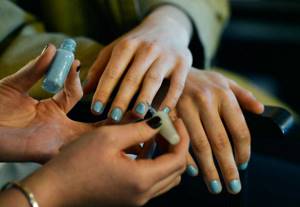
How is gel polish removed in a salon?
The salon procedure differs slightly from the home procedure. However, it is these seemingly insignificant details that determine the subsequent health of the marigolds and their presentable appearance.
Stage 1
Directly in the salon, before starting the procedure, you need to thoroughly wash your hands with soap and dry them with a paper or regular towel.
Stage 2
The master begins to saturate special sponges with a special shellac remover and attach them one by one to the nails. The design of the sponges allows you to wrap them around your fingers like small bags, allowing the product to act locally on the coating and increasing the effectiveness of the procedure. As a result, the liquid does not evaporate or spread over the entire finger, but is absorbed into the shellac and gradually dissolves it.
You can find out what hardware manicure is here. Read this article for summer manicure ideas 2016
Stage 3
After 10-15 minutes, the sponges are removed along with the shellac. If there are pieces of gel polish left on the nails, the master carefully pries their edges with an orange stick and removes the remnants.
Stage 4
If necessary, the nails are polished (usually there is no need for this after a salon procedure) and a decision is made to “rest” them or apply a new coating. The nail plates will not be damaged at all if they are immediately covered with a new manicure, but experts recommend taking a 1-2 week “vacation” for the nails, covering them with a moisturizing and strengthening varnish for quick recovery.
What methods do specialized centers use?
In most cases, damage to the nail plate is caused not by the shellac itself, but by its “erasing” that does not comply with the rules. Professional solvents - removers or a special device with a cutter, which in some salons replace regular nail files, since the principle of the procedure is similar, helps to remove shellac correctly in the salon. The second method, despite its apparent danger, is more preferable from the point of view of preserving the integrity and health of the cuticle, nail plate and skin around it. Choosing the right way to remove shellac in a salon is not so easy. More on this later.
Filing off the gel is a dangerous way to remove shellac
Cutting off shellac yourself is one of the most dangerous ways to remove the coating yourself. The procedure can be carried out in two ways:
- with the help of a professional framer;
- using a buff or a regular nail file.
Sawing should be done keeping the following points in mind:
- Only the top shiny layer of varnish needs to be removed;
- the base coating cannot be touched - it must remain intact (its difference from the main one is a delicate milky shade);
- When filing shellac near the cuticle, it is necessary to use a softer file.
Important! When filing, do not apply pressure to the surface of the nail.
In order not to damage the nail plate, for the procedure you need to purchase a file with an abrasiveness of 180 - 240 grit.
During filing there is a risk of injury to the cuticle. To prevent possible damage, the cuticle must be covered - both before and after the procedure - with nourishing oil, this will allow you to remove shellac as painlessly as possible.
How to remove shellac using solvents?
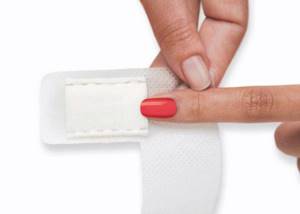
Solvents that are used in salons to remove shellac are called removers. They are produced by manufacturers of shellac itself, so a solvent of the same brand as the gel polish will be most effective.
You may be interested in: Manicure tongs: description, characteristics, photos and selection tips
How to remove shellac from nails in a salon? The master one by one applies prepared “compresses” to the fingers of cleanly washed and dried hands. This “compress” is a cotton pad, sponge or something similar (it all depends on the salon and the specialist), soaked in a special solvent. The impregnated material is usually attached to a sticky base, like a patch, so that the sponge soaked in solvent tightly covers the nail plate during the softening process, the duration of which also depends on the manufacturer and quality of the remover and can vary from 10 to 20 minutes.
After the time required for soaking the gel polish has passed, the master releases his fingers one by one and removes the layer of shellac with a special spatula. The softened coating, which looks like pieces of film, comes off the nail quite easily.
Some salons, keeping pace with the fashion industry, provide the opportunity to get rid of old manicure much faster due to the absence of the procedure for preparing “compresses”. Today there are ready-made impregnations. They are small bags, inside of which there is a prepared removal napkin. All you have to do is open the bag and dip your shellac-coated nail into it. This innovation is the brainchild of Chinese manufacturers, but some European companies were not slow to adopt similar experience.
It is quite rare to remove shellac in a salon using a remover method. Because there is a way that takes significantly less time.
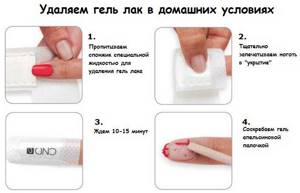
Removing shellac using foil
To remove shellac using foil, follow these steps. Instructions for removing gel polish:
- Cotton pads need to be cut in half.
- Cut the foil into plates so that you can completely wrap the nail.
- Soak a cotton pad with liquid, place it on the surface of the nail and wrap it in a strip of foil.
- Leave the resulting structure for 15 minutes. This time is enough to soften the gel layer.
After removing the foil, the shellac will become soft and can be carefully removed with a clean cotton pad. Sometimes small particles may remain on the nail. To remove residues you need to use a pusher.
The final stage is polishing the nails. There is a special file for it. It's called buff. It is advisable to take care of purchasing it in advance. The tool will make the nail plate smooth and shiny.
At the end of the procedure, you need to wash your hands again with soap and then use a cream with moisturizing or nourishing properties.
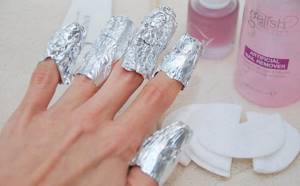
Removing shellac with a solvent: pros and cons
It is extremely difficult to say anything unambiguous about the solvent. Despite the fact that most fashionistas fall into a state of nervous trembling at the suggestion of cutting off shellac, the majority of craftsmen still prefer filing away. This attitude towards removers is due to their effect on the skin and nail plate.
Any solvent, even the highest quality one, contains acetone; nothing else will simply dissolve the varnish. What do you need to know about acetone? This is a powerful degreaser that, when exposed to the skin and nails, dries them out, which negatively affects not only the appearance of the hands and nails, but also significantly damages the structure of the nail plate, which becomes brittle and begins to peel. Acetone vapors are not harmless to the body; they can negatively affect the respiratory tract, causing irritation of the mucous membranes or even poisoning.
However, for several decades, acetone was indispensable for use in removing conventional varnishes, and no danger from its use stopped fashionistas, since there was simply no alternative.
After the shellac softening procedure, a good master will definitely use products to restore and strengthen the nail. Their use will help restore moisture lost during the process of removing gel polish and nourish the nail plate with restorative elements.
Removing gel polish at home: without foil, using caps
Foil is a substitute for modern devices, namely: caps, clips and clothespins; you can also add clips to this list. Both foil and all other devices perform the same function, the only question is the ease of use.
- Clamps, clips, clothespins are used to hold the fleece. They hold it tightly and prevent it from falling out.
- But we need to talk about the caps in more detail. This is an interesting invention, very easy to use, but so convenient - any woman will appreciate it.
- When using caps, we do not need any cotton wool or foil. We take the liquid that we will use to remove the coating and pour it directly into the cap, and then we put it on the nail.
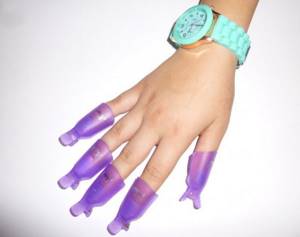
Removal with caps
- Due to the fact that the liquid acts directly on the nail plate, the gel will come off faster and with better quality. Keep the marigolds in the caps for about 15 minutes.
- After completing the procedure, the caps must be cleaned of possible residues and liquid. Then fill the device with cuticle oil and put it on your fingers again. Leave the handles for about 7 minutes.
- With the help of such devices, the procedure is much faster and more interesting, so we recommend that you take advantage of these new technologies.
How to remove shellac by filing?
To remove shellac by filing, the same device is used as for hardware manicure. The only difference is the use of cutters of different types.
The operating principle of the shellac remover is extremely simple. The cutter, which has special notches, rotates at a very high speed and literally cuts off the gel polish from the nail.
This procedure can be done with a regular file (masters in some salons still practice this method), but using a cutter significantly reduces the time spent on the process and also makes it much more comfortable.
So how do you remove shellac from nails using a machine in a salon? The most important thing in this procedure is that only a qualified master with good equipment will perform his task efficiently and painlessly. Shellac is removed from the nail with short stroking touches using a cutter. If the contact is prolonged, then both the cutter and, accordingly, the nail will heat up, which will lead to discomfort.
The work of the device on the nail ends when only the base layer remains of the coating. This layer is removed from the nail not with a milling cutter, but with a soft buff. This protects the nail not only from sawing, but also practically does not injure the nail plate.

Carbide cutter for removing gel polish using a machine
Metal or carbide cutters are made of hard metals and have a straight, oblique or cross-shaped cut. Metal nozzles are either regular (work in one direction only) or reversible (work both clockwise and counterclockwise). Unlike all other attachments, these attachments cut material, forming chips, not dust. These cutters are ideal for reducing the thickness of gel and acrylic when correcting and removing artificial nails. For gel it is necessary to use cutters with larger notches, because the viscous gel gets stuck between the teeth and clogs the tool. Metal carbide nozzles work quickly, do not cause heat, and generate almost no dust.
It is necessary to take into account that if we perform a hardware manicure at 10,000 - 15,000 rpm, then filing occurs at a maximum speed of 30,000 - 40,000 rpm. This allows the nail plate to heat up less. Some masters say that it is very easy to saw through a nail with a cutter, this is harmful, cuts are formed, etc. It’s better and “safer” to remove it with a file or soak it in acetone.
If the masters correctly teach the technique of hardware manicure, position your hand, show you how to and how not to work with the device, there will be no cuts.
Why shouldn’t you be afraid of removing shellac with a machine?
Many salon visitors are afraid of just the sight of a rotating cutter, which is terribly similar to a device for drilling teeth. At the same time, there are various horror stories telling about the painfulness of the procedure or cases of sawing through the nail to the flesh.
But any experienced master will be able to tell you how to remove shellac in a salon using a machine. Moreover, everything is absolutely safe and also painless.
The device only removes the artificial coating; the cutter does not come into contact with the nail at all. An indicator to stop working with a cutter is the base coat, which is sanded with a soft buffer at the final stage. So no master will saw through the nail.
You don't have to worry about pain either. All that can be felt during the procedure is a slight tickling on the nail.
Ceramic cutter for hardware removal of gel polish
Ceramic cutters are a new product on the nail industry market. One of the distinctive properties of ceramic cutters for nail correction is their very high mechanical strength and, as a result, high durability and wear resistance. Also, one of the most important qualities is the high heat resistance of the material - they do not heat up during operation. The composition of ceramics is very complex - clayey substances and quartz, feldspar, and bone ash are plastic. When these materials are fired, a very durable substance is formed that has the above qualities. You can immediately feel the difference - ceramic cutters cut the material very softly, thanks to their high cutting ability. There is no vibration felt at all. If we compare it with carbide cutters, then one ceramic cutter will “work” three or four carbide cutters.
How long does the procedure take?
So, how long does it take to remove shellac in a salon? This procedure is much faster than application. Especially provided that it is performed by an experienced master.
But here everything depends on the chosen method.
Removing shellac coating with a remover will take from 20 to 40 minutes. It all depends on the chosen solvent - some soak shellac in 15 minutes, some compositions require half an hour. Plus, by this time, the master’s work itself, removing shellac from the nail, will take no more than 10 minutes.
Hardware removal of shellac is much faster. It will take no more than 15 minutes to cut off the coating with a cutter and polish the nails with a buff.
Tools for removing gel at home
Typically, salons use two methods to help remove gel polish: using a special device or using a liquid to soften the composition. The first option is quite fast, since there is no need to prepare for it, since the attached attachments cut off the gel at a fast speed.
The second option involves the use of a softening liquid, which is applied to the plate. The method is more gentle, since the risk of accidental damage to the upper stratum corneum of the plate is reduced.
To remove shellac, you can only use the second method, since the increased adhesion of the pigment to the nail complicates the method of removing the work. Even the coarsest nozzles have difficulty cutting off the decorative coating, and there is a high risk of accidentally hitting the nail.
To perform removal, prepare tools and consumables in advance:
- Shellac remover;
- Metal pusher or orange stick;
- Bafik;
- Cotton pads;
- Foil;
- Manicure clothespins that fit onto your fingertips (not always used).
Since there is a risk of damaging sensitive skin in the periungual area, pre-treat the tools you use with an antiseptic and apply a rich, nourishing cream to your hands.
To distribute the solution, you can use a brush or a cotton swab - rely on your convenience.
Comparison of two methods
| Characteristic | Hardware method | Liquid method |
| Duration of the procedure | 10-20 minutes | 20-40 minutes |
| Cost of instruments for the procedure | From 4000 rubles | From 200 rubles |
| Possibility of allergic reactions | None | The liquid may cause individual intolerance by the client |
| Possibility of injury | Higher risk due to the inexperience of the technician. | There is a chance that after removal there will be small wounds in the cuticle area, but this depends on the location of the capillaries of each client. |
| Which masters are recommended? | For professionals. | Beginners, but even professionals do not completely abandon this method. |
| Which clients are not recommended? | With very brittle nails. | There are no contraindications. |
